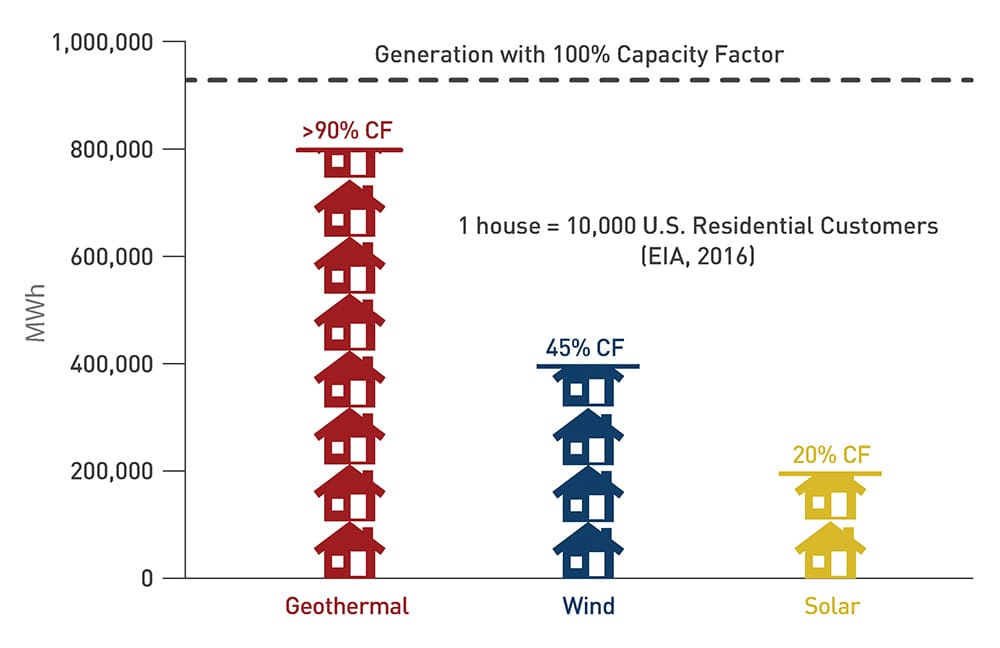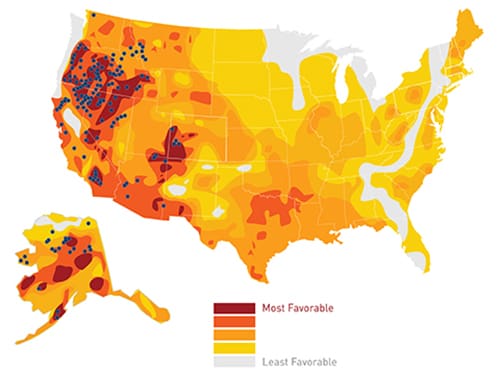Geothermal energy is a diverse energy source, produced by harnessing the heat that flows from the Earth's core to its surface. Historically, there have been two main ways to harness geothermal resources – through geothermal heat pumps or hydrothermal resources. Geothermal heat pumps are an example of direct-use; they capture heat from geothermal resources and redirect the energy for uses such as space heating and cooling. Hydrothermal resources use existing hot water or steam in naturally occurring regions, where the resource is at or near the Earth’s surface. Similar to thermal electric power generation or hydropower, hydrothermal steam or hot water can also be captured to drive a turbine, generating clean electricity.
Geothermal energy is clean, available and “always on.” A 2019 Department of Energy (DOE) study, GeoVision, highlighted the potential of combining geothermal energy with other energy sector technologies to tap into regions once thought impossible. Recent efforts to connect these technologies have included $165 million in grant funding to the Geothermal Rising Consortium via the DOE’s GEODE initiative. This program supports “enhanced” or “engineered” geothermal systems (EGS). EGS uses existing and safe oil and gas technologies to access larger geothermal resources and can be found at any temperature above “ambient temperature” where an energy conversion can occur.
A fourth, lesser-known, geothermal technology is the closed-loop system. Closed-loop geothermal systems are just like they sound; clean water is circulated through a continuous system, creating a sealed radiator-like design. This eliminates the need for injection or extraction of any fluids from the earth. These systems can provide firm, dispatchable energy and heat for a wide range of applications.

Despite the great potential of geothermal to meet many of our clean energy needs, the U.S. has only 3.7 GW of capacity, which is a small fraction of its potential. According to GeoVision, improved technology development and reduced costs could increase geothermal electricity generation to an estimated 60 GW of always-available, flexible, clean and dispatchable electricity. To unleash these 60 GW, the National Renewable Energy Laboratory (NREL) has targeted cost reductions to $45 per MWh, which is a 90% reduction from 2019 prices.
The U.S. must continue to reform geothermal policy to drive innovation and accelerate deployment.
A Geothermal plant will generate 2-4 times as much electricity as a wind or solar plant of the same capacity

Geothermal energy’s generation capacity can be 2-4 times greater than other forms of renewable energy.
Increased R&D Funding - Research into hybrid opportunities for geothermal energy as well as new revenue streams to maximize value is essential. This can include critical minerals recovery and using geothermal resources to produce low-carbon hydrogen. Assessments should be conducted to review barriers to all types of geothermal energy, with a technology-inclusive emphasis.
Support for Demonstration Projects - The wide array of geothermal technologies demonstrates the need for technology-inclusive legislation, as systems are continuously being improved upon. That said, there must also be increased investment into the demonstration and deployment of new innovations, like EGS.
Improving Access to Federal Lands - Today, over 70 percent of all geothermal energy production in the U.S. is on federally managed lands. Because of this, accessing federal land should be prioritized while also improving the ability to access land as a whole. Federal land should be used to continue research while illustrating successful “proofs of concept,” in order to encourage private landowners and states to install geothermal resources. Recently, the DOE’s Geothermal Technology Office (GTO) announced federal sites for geothermal heating and cooling applications. A wider range of geothermal technologies should be considered for similar opportunities.
Secure Categorical Exclusion for Geothermal Development - One policy reform that will have major benefits for the geothermal industry is the optimization of permitting, and development of regulatory certainty. Today, geothermal developers face long project timelines which can be prohibitive for seeing projects completed. Because a majority of potential geothermal resources are on federal land, most geothermal exploration is subject to a lengthy National Environmental Protection Act (NEPA) review. Granting the industry a type of environmental approval called a ‘categorical exclusion’ would spur geothermal investment and offset much of the upfront cost for geothermal projects.
Invest in Resource Assessment and Data for Geothermal Development - Another policy area to encourage geothermal development is the improvement of resource assessment and data collection. The last major federal mapping survey of geothermal resources in the U.S. is from early 2018, and new technologies allow the industry to unlock previously unattainable resources. In order to make effective policy decisions moving forward, we must have the best information available. As the Western Governors Association noted, “Increasing federal funding for resource assessments, coordinating efforts to target areas with the greatest potential, improving the federal repository of data relevant to geothermal development, and leveraging data from the oil and gas industry, as well as new technology, will increase our understanding of subsurface resources and foster additional geothermal development.”

Blue dots indicate existing geothermal sites, while shaded areas represent the most suitable regions for enhanced geothermal systems.
Posted on April 29, 2025 by Jeremy Harrell
Posted on April 3, 2025 by Hillary O’Brien and Mitch Kersey
Posted on January 16, 2025 by Lisa Epifani
